Comet Observations with the Boston University Imaging System
The high sensitivity and wide field of view of our 0.1-meter imaging system
are ideal for studying the large scale structure of large comet tails.
We recorded the earliest image of comet Hale-Bopp's sodium tail in March,
1997.
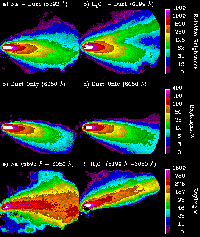 |
Hale-Bopp's three tails. a) Average of two images at 5893 A, March
17, showing both dust and sodium atoms. b) Average of three images at 6199
A, March 20, showing dust and the ion water tail. c,d) Images at 6050 A
(off-band) on March 17 and 20, respectively, showing dust only. e) Image
of the sodium tail; difference of 5893 A and off-band images. f) Image
of the ion water tail; difference of 6199 A and off-band images. (from
Figure 1 of Wilson
et al., Three Tails of Comet Hale Bopp, GRL,
25, 225-228, 1998.) |
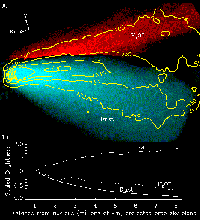 |
Comparisons of Hale-Bopp's tails. g) Superposition of the water, Na,
and dust tails. The dust tail has been placed ``on top" of the ion tail
to show its full extent. Contours are the brightness of the sodium tail
in Rayleighs. h) Cross-tail integrated brightness profiles of the three
tails. The tail brightnesses are integrated perpendicular to the radial
vector from the nucleus, and plotted versus distance from the nucleus.
Unlike the dust and ion tails, the sodium tail increases in brightness
with distance from the nucleus. (from Figure 1 of Wilson
et al.,
Three Tails of Comet Hale Bopp, GRL, 25, 225-228, 1998.) |
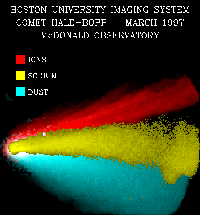
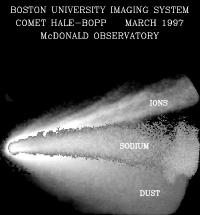 |
Another representation of the three tails of comet Hale-Bopp. This
image represents the sum of three separate pictures taken through filters
that capture emission for water ions (at a wavelength of 6199 Angstroms),
dust (at 6050 A), and sodium gas (at 5893 A). The brightest portions of
each of these emissions are shown using red, blue and yellow colors, respectively.
The sodium tail has been artificially enhanced to make it more visible.
Photo credit: J. Wilson, J. Baumgardner, M. Mendillo (Boston University) |
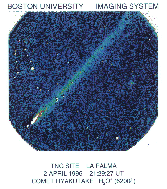 |
The ionized water tail of comet Hyakutake, imaged from the Canary Islands. |